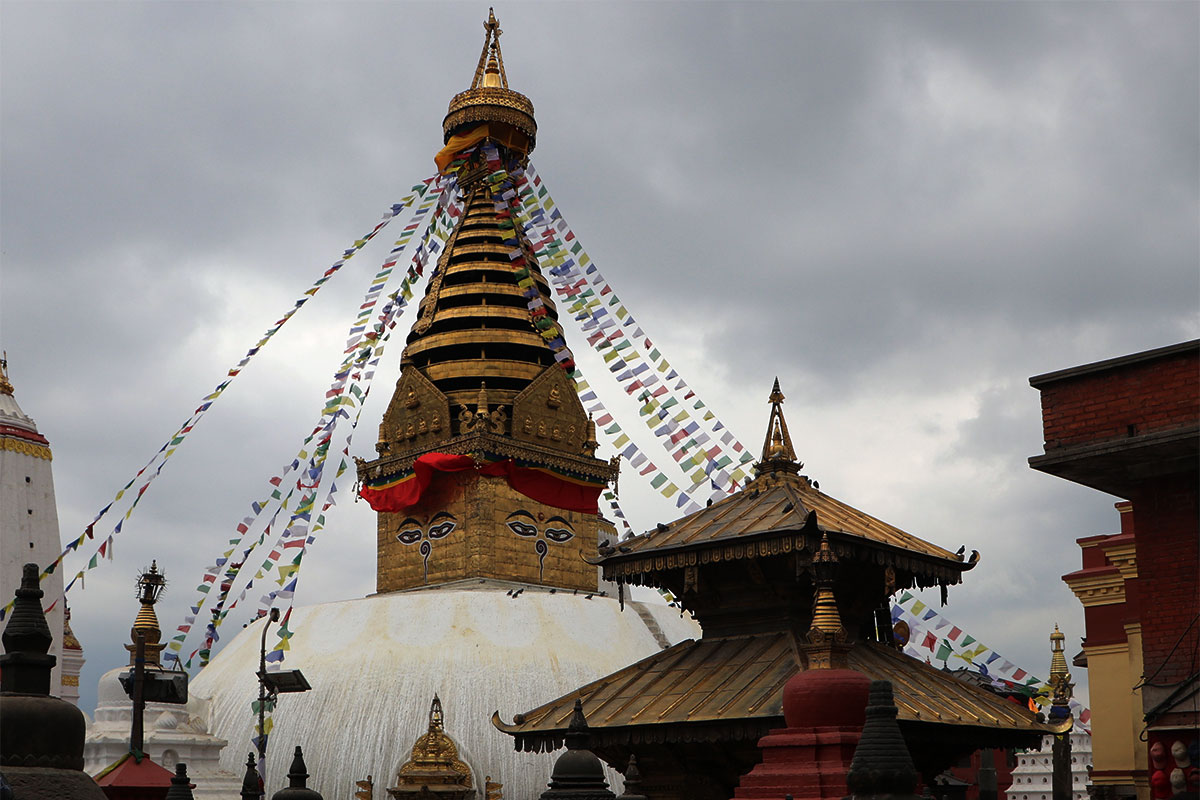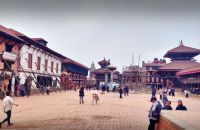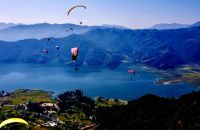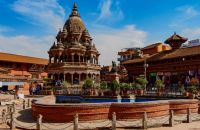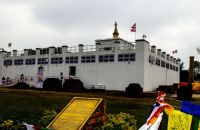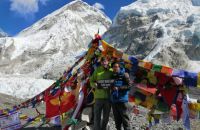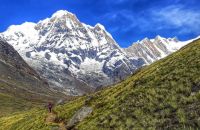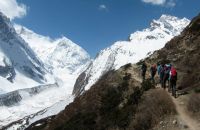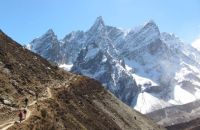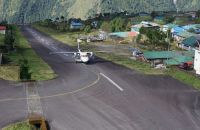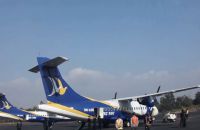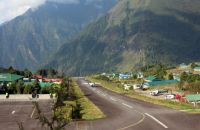Talk with our local travel specialist who can help organize your trip.
Places to visit in Nepal - Inside and Outside of Kathmandu Valley
Table of Content
Walking under the shadows of Nepal Himalaya not only takes you close to the mountains, it also gives you an opportunity to immerse yourself in fascinating mountain cultures that have stood the test of time. Visit Kathmandu, Pokhara and Chitwan the three most popular destinations frequented by tourists in Nepal.
Kathmandu has 7 UNESCO World Heritage Sites. Nepal has been a spiritual abode for mystics and sages. Lumbini (the birthplace of Lord Buddha), Muktinath Temple, Gosainkunda, the ancient Hindu temples in Kathmandu, the monasteries and meditation caves blessed by Padmasambhava in Mustang and Dolpo etc. are some of the sacred pilgrimage sites frequented by devout pilgrims in Nepal.
Kathmandu Valley
Kathmandu lies in a deep valley surrounded by magnificent hills all around. This historic city is the capital of Nepal and home to seven of the ten UNESCO World Heritage Sites in the country - Pashupatinath Temple, Boudhanath Stupa, Swayambhunath Temple, Kathmandu Durbar Square, Patan Durbar Square, Bhaktapur Durbar Square and Changu Narayan Temple.
Surrounding the valley are verdant hills that offer great opportunities for day hikes, nature tours, and mountain biking adventures.
The medieval Newari villages surrounding the city are living museums or heritage sites and great locations for excursions or walking tours.
Kathmandu is the economic and political center of the country. The main city center has a mix of old traditional buildings and modern high rises. There are many modern shopping malls and fine-dining restaurants serving cuisines from the world over. The traditional Newari eateries and local food stalls are ideal for food tours. A day is not enough to explore the whole city as the city is actually made of three ancient medieval kingdoms and just too vast to be explored in one day.
The three medieval cities inside Kathmandu valley are:
Kathmandu
The medieval city of Kathmandu was earlier known as Kantipur in the olden days. Together with Patan and Bhaktapur, it was one of the three major Malla kingdoms inside the valley.
After the Gorkha King Prithvi Narayan Shah wrested power from the Malla Kings, Kathmandu became the power center. The king ruled over the country from the palace at Basantapur Durbar Square and till today Kathmandu has remained the center of power of the whole nation.
The pagoda roofed Taleju Temple, Hanuman Dhoka Palace, Nau Talle Durbar, Kumari Bahal (House of the Living Goddess) and courtyards with intricate stone, wood and metal works are some of the gems of this medieval durbar square.
Patan
Patan or Lalitpur is an ancient kingdom that lies on the south-central part of Kathmandu. Also known as the 'City of Artisans’, it is known for its rich cultural heritage, amazing traditional arts, crafts and architecture. The pride of Patan is the Patan Durbar Square, a UNESCO World Heritage Site.
The city, which was originally built in the shape of a Buddhist Dharma Chakra, is filled with ancient Buddhist stupas, chaityas and viharas (Buddhist centers of learning).
Bhaktapur
Bhaktapur lies in the eastern corner of the Kathmandu valley. Once the royal seat of the Malla kings, the name of the city literally translates to “City of Devotees”. Bhaktapur is one of the best-preserved UNESCO World Heritage Sites.
Historically more isolated than Kathmandu and Patan, it has its own distinct culture and language.
Bhaktapur Durbar Square with its well-preserved palace courtyards, temples, wood, metal and stone artwork are worth exploring. Palace of 55 Windows, Golden Gate, Nyatapole Temple, Pottery Square, Bhairav Temple etc. are some of the jewels of this ancient palace square.
The city is also famous for its special type of curd called ‘Ju Ju Dhau’ (King's curd). Read more- places to visit in Bhaktapur
Sagarmatha National Park
Home to Mount Everest, the tallest mountain and Earth and several peaks above 6000 and 7000 meters, Sagarmatha National Park is one of the highest national parks in the world.
Covering an area of 124,400 hectares, the park is a UNESCO Natural World Heritage Site.
Lying in the Solu Khumbu Region, it is home to endangered Himalayan wildlife and vegetation including Snow leopard, red panda, Himalayan Tahr and 118 species of birds.
The park is filled with dramatic glaciers, mountain lakes, soaring peaks, thundering glacial rivers and forests of pine and rhododendron. The traditional Sherpa villages that lies within the park are cultural treasures. Far removed from the culture of the Nepalese Hindus in the lowlands, the Sherpas have their own distinct culture and language. They follow Tibetan Buddhism and culturally, are closely aligned to Tibetans.
One can choose any of the popular Everest treks and enjoy a walk through the Sagarmatha National Park. Some of the most popular destinations inside the park include Lukla, Namche, Everest Base Camp, Tengboche, Hotel Everest View, Khumjung, Gokyo Lakes, Gokyo Ri and Kala Patthar. The most popular trek inside the park is the Everest Base Camp Trek.
Annapurna Conservation Area
With a total area of 7629 sq.km. Annapurna Conservation Area is Nepal’s largest protected area. The conservation area is home to diverse cultures, Himalayan wildlife and vegetation. Here you will find villages of Gurungs, Magars, Thakkalis, Mananges, Lobas, Chettris and Brahmins.
The deepest gorge in the world - the Kali Gandaki Gorge, Annapurna Range, mountain lakes and river valleys all lie within the protected zone of ACAP. 518 species of birds, 105 mammals and 1226 species of plants call this area home.
The trekking trails located within the ACAP zone are some of the oldest in the country. The Annapurna Base Camp Trek, Annapurna Sanctuary Trek, Ghorepani-Poon Hill Trek and Annapurna Circuit Trek are some of the classic and popular treks. The rhododendron forests covering the trails are some of the largest in the world.
Chitwan National Park
Chitwan National Park, the first national park in Nepal, is a UNESCO World Heritage Site. Lying in the Terai belt, 148km from Kathmandu, the lush tropical jungles and humid climate of Chitwan is an ideal home for several species of vegetation and animal species.
It is home to the endangered one-horned rhinoceros, Bengal Tiger, and a host of birds, mammals and tropical vegetation. It used to be the hunting grounds of kings and royalty before the area was declared as a protected national park in the early seventies.
The park offers visitors myriad opportunities to get close to nature and its endangered inhabitants. One can take a jungle safari and explore the habitats of the one-horned rhino, Royal Bengal tiger, marsh muggers, wild boar, monkeys and more than 500 species of birds.
Enjoy elephant ride, canoe ride, bird watching tour and nature walk. Inside the park are settlements of the Tharu tribals who been living in these jungles for centuries. They have a unique culture and tradition which is very different from the mainstream Nepalese Hindu culture. If you book a Chitwan tour you will get to experience not only the wildlife but the fascinating culture of the Tharus as well.
Langtang National Park
Langtang National Park covers an area of 1710 sq. km. is a Himalayan national park that lies close to Kathmandu.
The national park is home to a variety of endangered flora and fauna including red panda, musk deer, snow leopard Himalayan black bear and 250 plus species of birds. Lying within the protected zone of the national park are ethnic villages of the Tamangs, a mountain community that migrated from Tibet centuries ago.
The majestic Langtang Range and Ganesh Himal Range lie within the park. In addition, 70 glaciers and sacred mountain lakes like Gosainkunda, Bhairav Kunda, Saraswati Kunda and Parvati Kunda, all lie within this beautiful national park.
The Tamang Heritage Trail, a trekking trail located inside the Langtang National Park takes you to the traditional villages of Tamangs and lets you experience their unique lifestyle.
Though the 2015 earthquake devastated most parts of Langtang, including Langtang Village which was completely wiped out by an avalanche, the rebuilding efforts have resulted in the building of new structures and teahouses with modern amenities.
The national park borders Tibet and it’s possible to view Tibetan peaks from places like Kyangjin Ri, Tserko Ri and Yala peak.
Lumbini
Lumbini, the birthplace of Lord Buddha, lies in the Terai region in southern Nepal. Located 272km from Kathmandu, one can travel to Lumbini by air as well as overland. One of the chief Buddhist pilgrimage sites in the world, this sacred site is a protected UNESCO World Heritage Site. Here one can find tangible proof of Lord Buddha’s existence.
The Mayadevi Temple (where Queen Mayadevi is believed to have given birth to Lord Buddha), Puskarini Pond (where Lord Buddha received his first ritual bath), Ashoka Pillar, Sacred Garden and a host of grand Buddhist monasteries built by Buddhist countries from the world over(Thailand, South Korea, Vietnam, Sri Lanka, Myanmar etc.) are the attractions of Lumbini.
Tilaurakot, an archeological site lying a few kilometers from Lumbini, is also a pilgrimage site. It is believed to be the site of the Shakya kingdom where Lord Buddha spent the 29 years of his life.
Upper Mustang
A trip to Upper Mustang takes you to whole new world altogether. Lying in a protected zone in northern Nepal, Upper Mustang was once known as the ‘Kingdom of Lo’ and was ruled by the king of the Lo dynasty. It remained a kingdom recognized by the Shah kings till the monarchy was abolished in the country 2008.
Lying in the Tibetan plateau, Upper Mustang has close cultural and religious ties with Tibet. The customs and traditions of the people are similar to the ones followed by the Tibetans. As the region lies close to Tibet, the ancient Himalayan salt trade route weaved past this ancient region.
Untouched by modernity and western civilization, life in Upper Mustang seems to be suspended in time. The people still follow the lifestyle followed by their ancestors. Buddhism is the dominant religion.
The region is filled with ancient Buddhist monasteries, mani walls, chortens and stupas. Ancient cave dwellings, frescoes and paintings have been discovered in the recent past. Known as ‘Sky caves’, archeological explorations to these caves have unearthed human remains that are more than 2000 years old, ancient Buddhist manuscripts, paintings and relics.
Most of the trips to Upper Mustang culminate at the walled Kingdom of Lo. Filled with traditional flat-roofed houses and lying in the desolate desert-like terrain, the Kingdom of lo seems like a place from a fairy tale. A stroll through this ancient city will take you past old alleys paved with stones.
The palace of the king, Dragkar-Thegchen Ling Gompa, Choede Gompa, Thupchen Gompa, Jampa Monastery and the Monastic Museum are not to be missed attractions inside the walled city.
A trek to Upper Mustang is possible even in the monsoon season, as the region lies in the rain shadow of the Trans Himalayan region and remains dry even when the whole of Nepal is lashed by torrential monsoon rains.
Panauti
Panauti is quaint and interesting destination south-east of the Kathmandu valley. When you enter the town it feels like it is exactly the way it was when the founders built the town. A nostalgic environment covers the narrow town streets and ancient structures.
Visitors to this place will often find colorful stones, petals and other items laid out on the street as a sign to welcome everyone visiting Panauti.
Panauti is regarded as a very holy site by a lot of Hindus because of the confluence of the two rivers-Roshi Khola and Punyamata Khola. A visit to this place is considered to free all souls from sins and anxiety.
Nagarkot
Nagarkot, lying just 32 km north-east of Kathmandu is a peaceful paradise surrounded by green hills and traditional villages. Lying on the crest of a hill, Nagarkot is famous for its magical sunrises and sunsets.
This is the place closest to Kathmandu from where one can view Mount Everest and other Himalayan peaks on a clear day. Surrounded by endless stretches of hills and green forests, the peaceful ambiance of Nagarkot is sure to soothe your senses and ease your stress. Comfortable and luxurious resorts offer overnight stays and a sublime experience.
Nagarkot serves as a favorite weekend getaway for locals as honeymooners. Tourists flock here to watch the sunrise and the Himalayan panorama. It is also a popular day hike destination.
The trails leading from Nagarkot to Chisapani and Changu Narayan are some of the favorites of day-hikers. The trails take you past terraced fields, dense forests and traditional Tamang and Newari villages.
Nagarkot is is the destination for you if you want to escape from the pollution and chaos of Kathmandu.
Dhulikhel
Lying on the eastern rim of the Kathmandu valley, Dhulikhel is an old Newari town filled with traditional homes, paddy fields and beautiful resorts overlooking the Himalayan ranges.
Depending on the traffic, it takes around one and a half to two hours to reach Dhulikhel from central Kathmandu. Surrounded by verdant hills and forests one can take a day hike and explore the area surrounding Dhulikhel. A stroll around the Newari settlements will give you an insight about the rural lifestyle.
Dhulikhel is also well-known for its breathtaking sunrises and sunsets. The sun rising and setting over the snowy summits of Langtang Lirung, Gauri Shanker, Dorje Lakpa and Melungste is sure to take your breath away.
Like Nagarkot, Dhulikhel is also a honeymoon destination. The tranquility and the abundant nature surrounding this old settlement promises a peaceful stay. There are many beautiful resorts that offer comfortable overnight stays.
Daman
Daman is the place to escape to if you want to go to a place in the midst of nature and few tourists around. Located about 75km away from Kathmandu.
Daman is a beautiful hill resort offering panoramic views of the Himalayan mountains including Mount Everest. Surrounded by mountains, green hills and traditional villages, Daman has a host of budget as well as luxury hotels. As this scenic hill resort lies at an altitude of 2500 meters, one can experience snowfall during the winter months (late December and January).
Though situated in a very scenic location, very few tourists tend to visit this place. Uncrowded and peaceful, the views of the Himalayan peaks from Daman are awesome. While here, one can enjoy outdoor activities like nature tours, village tours and if you are an ardent cyclist, a mountain biking tour.
Bandipur
Bandipur is a hilltop settlement and a municipality in Tanahun district 143 km west of Kathmandu valley. A small settlement of the Newari community, Bandipur is slowly becoming a popular tourist destination because of its well-preserved traditions and old-world charm. One can take short hikes and enjoy excellent views of the Himalayas.
The distinct Newari culture and old-world architecture combined with excellent mountain views make this a must-visit destination in Nepal. Read more things to do in Bandipur
Gorkha
Located about 4 hours drive from Kathmandu, the hilly district of Gorkha occupies a very important place in the history of Nepal. It is from the hills of Gorkha that the first Shah king, Prithvi Narayan Shah began his unification campaign of Nepal. His descendants ruled over Nepal for about two centuries till the abolition of the monarchy in 2008.
The must-visit places in Gorkha include the Gorkha Durbar or palace, the hilltop Manokamana Temple, Gorakh Nath Temple and Gorakh Kali Temple. The Magar and Ghaley villages in the district are also worth visiting to experience their unique lifestyle.
The festival of ‘Dashain’, in Kathmandu actually begins with the floral offerings being carried by priests from the temple in Gorkha to Kathmandu. The treks leading to the base of Mount Manaslu, the eighth highest peak in the world, begin from Gorkha.
Pokhara
Pokhara can be called the favorite city of tourists who travel to Nepal. Lying about 200 km (120 miles) west of Kathmandu, Pokhara is Nepal’s second-largest city. The city lies on the banks of the serene Phewa Lake and is surrounded by green hills and soaring snow-capped Himalayan peaks including the iconic Machhapuchhre or Fishtail Peak.
Most of the treks to the Annapurna Region begin and ends in Pokhara. As there’s so much of natural beauty around, the lakeside city is a popular hangout for honeymooners. From boating in the jewel-like lake Phewa Lake to romantic nature walks around Begnas Lake, Sarangkot Hill or the quaint Lakeside area, couples find Pokhara one of the best destinations to spend their together time. Not only couples, the city has much to offer to all types of travelers.
Ilam
The beautiful district of Illam is the tea capital of Nepal. Lying in the eastern most corner of the country bordering Darjeeling, in India, Ilam is filled with rolling green tea gardens, which serve as a treat for sore eyes. One of the most developed districts in Nepal, Illam is a leading producer of tea, ginger, cardamom, potato and onion. The tea that is grown in Illam is exported to countries the world over.
Tea tourism is highly popular in the district. Tourists from Europe and other western countries visit Ilam to experience life at the tea gardens. There are homestays available around the tea estates. One can take tea garden tours and watch how tea leaf is processed. Kanchenjunga, the third highest mountain in the world can be viewed in all its glory from many places in Ilam.
Janakpur
Janakpur, one of the major Hindu pilgrimage sites, in the Terai region of Nepal is regarded as the birthplace of Sita, the wife of Lord Rama.
According to the Hindu epic Ramayana, the maternal home of Sita is Janakpur, the kingdom ruled by King Janak (Sita’s father). The colossal Janaki Mandir or Temple is the most important landmark of this place. According to Hindu legend, the marriage of Rama and Sita was solemnized near the place where the temple is built.
Dhanushadham, where a fragment of the bow that Rama broke to win Sita’s hand in marriage, also lies close to Janakpur.
For followers of Lord Rama, who is regarded as an incarnation of Lord Vishnu, Janakpur together with Ayodhya, Brij and Kashi are four ‘parikrama’ points of their pilgrimage.
Every year the temple is crammed with devotees during Ram Nawami and Biwaha Panchami. The marriage of Lord Rama and Sita is enacted by actors during Biwaha Panchami.
Apart from being famous as the hometown of Sita, Janakpur is also popular for its Mithila Art. It is known as the centre of Mithila Art and culture which traces its roots back to the 7th century. Mithila Art, which is also known as Madhiubani Art in India, was created by rural women who decorated the walls of their home with their art work. Their artwork records the lives of the rural folks as well as depicts the mythological folklores.
- Written by: Naba Raj Amgai
- Updated: Tuesday Feb 2, 2021

